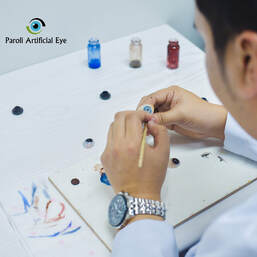 An Ocularist painting a Prosthetic Eye
An Ocularist painting a Prosthetic Eye
An Ocularist, or an Ocular Prosthetist as defined by Keith R. Pine, is someone who specializes is creating and fitting an Ocular Prosthesis or an Artificial Eye. In a usual case, a person who lost an eye due to trauma or and end stage disease visits an Ocularist to have a Prostehtic Eye made.
The fitting process may vary from every specialist. Commonly, an Ocularist would typically include taking an impression of the inside of your eye, creating and altering the shape of a plastic shell, painting the palstic, especially the Iris, and fitting the Ocular Prosthesis.
There are also prefabricated Ocular Prostheses available with different colored irises and different sizes, where an Ocularist may simply choose the best fit for the time being.
But due to the custom-made prosthesis having better adaptation, comfort, aesthetic, the custom-made prosthesis is often chose by many Ocularist.
But due to the custom-made prosthesis having better adaptation, comfort, aesthetic, the custom-made prosthesis is often chose by many Ocularist.
Although there isn't really a course in the creation of a Prosthetic Eye, an Ocularist may develop their skills from different background disciplines, for example, in other countries they may acquire it from their Medical background, and in the Philippines, it's usually of the Optometry curriculum. Other fields include Dental, Nursing, Biology, Medical Arts and Illustration.
An Ocularist in the Philippines
In the Philippines, according to Republic Act 8050, a person who fits a Prosthetic Eye to a patient needs to be an Optometrist in good standing. Meaning, they should be a Doctor of Optometry, a board certified Optometrist who passed the Optometry Licensure Exam, and has a valid unexpired license. The practice should also be done in a place registered to conduct Optometry practices.
